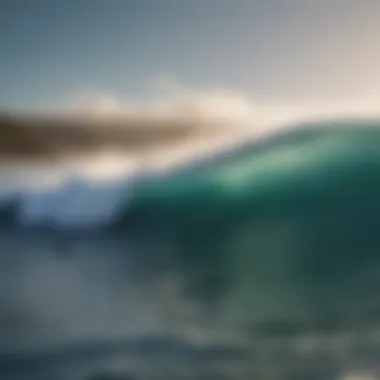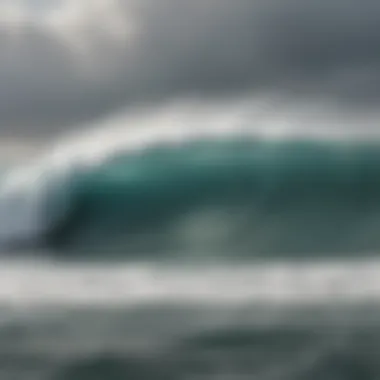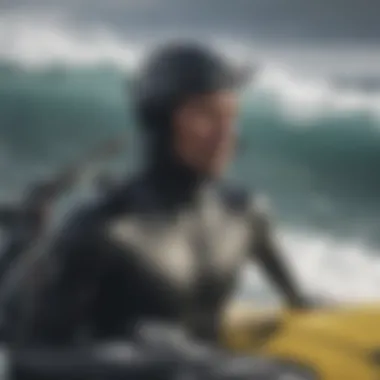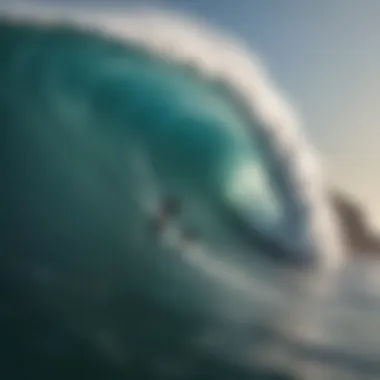Exploring Mavericks: The Art of Big Wave Surfing


Intro
Mavericks is not just a surfing spot; it’s a rite of passage for those brave enough to take on the mammoth waves that crash against the rugged coastline of California. Each winter swell brings about a spectacle that draws both seasoned pros and enthusiastic newcomers. Yet, before one can ride the untamed waters of Mavericks, understanding the nuances of big wave surfing is crucial.
Not only are physical skills put to the test, but mental fortitude plays an equal part in conquering the waves. The experience demands respect for the ocean and a thorough knowledge of the environment and its ever-changing conditions. Mavericks signifies more than just adrenaline; it embodies a culture rich in camaraderie and resilience.
With that in mind, let’s plunge into the depths of surfing techniques, gear selection, and everything else that makes Mavericks a towering titan in the surfing world.
Understanding Mavericks Surfing
Mavericks surfing holds a unique place in the world of big wave riding, specifically due to its fascinating blend of thrilling challenges and rich history. This segment serves as a vital introduction to the conditions and characteristics that set Mavericks apart from other surfing locales. Understanding the intricacies of these waves—and what makes surfing here so desirable—provides both a contextual foundation and insight into the sport’s demands.
The Origins of Mavericks
The inception of Mavericks can be traced back to the early 1970s when a handful of local surfers recognized the area's potential. They were drawn to the sheer power and size of the waves that consistently crash at Half Moon Bay. This discovery would soon give rise to an iconic surf culture, drawing enthusiasts from around the globe. Moreover, Mavericks is named after a famous local dog, a Labrador Retriever that was a frequent companion to surfers. It symbolizes the area’s community bond, which is tightly woven into the fabric of surfing history.
Geographical Features of Half Moon Bay
Half Moon Bay’s geographical features form the backbone of the title's allure to big wave surfers.
Unique Topography
The distinctive underwater topography plays a significant role in wave generation. A unique feature of this topography is the submerged reef that juts out from the coastline. It creates a natural amphitheater that amplifies swells, allowing them to reach monumental heights. Surfers appreciate how this bottom contour shapes the waves, leading to the predictable yet unpredictable nature key to testing one’s skills.
Wave Formation
The wave formation at Mavericks arises from the vast Pacific Ocean swells that have traveled thousands of miles. These swells hit the continental shelf just off the coast before crashing onshore, creating sections that can reach heights of over 25 feet. The composition of the waves—steep and powerful—demands not only technical skill but also respect from anyone stepping onto the water. For enthusiasts, these characteristics are not just appealing but vital for honing their craft.
Climate Influences
Climate plays an essential role in the Mavericks’ surf conditions. Winters are notoriously stormy, generating massive swells that attract surfers. The unique weather patterns tied to El Niño and La Niña significantly influence the size and frequency of the waves. Surfing enthusiasts often keep a close eye on these factors, with many spending idle hours checking weather reports and swell forecasts. The connection between climate and wave action reflects an intricate dance of nature—which surfers must learn to navigate.
The Mavericks Surfing Event
History of the Event
The Mavericks surfing contest, officially established in 1999, has burgeoned into one of the most prestigious events in the big wave surfing calendar. Signified by its high-performance criteria and challenging conditions, the event invites only the bravest and most skilled surfers. This event has witnessed both local and international champions pushing the boundaries of what is possible on a surfboard, helping carve out the narrative of big wave surfing as a competitive sport.
Major Competitions
Each winter, the competition situation unfolds as surfers anxiously await the perfect swell. The global prestige of Mavericks ensures that only the top athletes in the sport attend. The adrenaline rush and electric atmosphere attract crowds and avid surf aficionados alike, turning the isolated coastline into a vibrant hub of activity. The engagements, emotions, and challenges observed during these competitions highlight the extreme nature of surfing as both a sport and a lifestyle.
Cultural Significance
Culturally, the Mavericks surfing event holds profound meanings for the local community. It brings together surfers, spectators, artists, and local businesses, establishing a shared identity around the sport. Mavericks isn’t merely a place for athleticism; it embodies a lifestyle filled with camaraderie, respect for nature, and a pursuit of passion that affects everyone involved. This cultural tapestry provides context to the bravery and artistry on display when the waves are at their zenith.
"To surf at Mavericks is to dance on the edge of chaos, where nature’s whims become man's greatest adventure."
The essence of Mavericks surfing lies in its historical roots, geographical uniqueness, and cultural significance. Understanding these facets enriches one's appreciation for the sport itself, painting a fuller picture of why Mavericks resonates with so many in the surfing community.
The Art of Big Wave Surfing
Big wave surfing is not just a sport; it’s a lifestyle crafted through dedication and grit. Understanding this art is paramount for anyone who seeks to ride the towering giants at Mavericks. Mastering the balance of technique, physical and mental training is essential. Surfers know that it’s not just about catching the wave; it’s about reading it, respecting it, and knowing how to navigate through nature’s fierce power. In this section, we’ll explore the intricate techniques, physical demands, and mental preparation needed to excel in this daring pursuit.


Techniques for Mastering Large Waves
Paddling Strategies
Paddling strategies form the backbone of successful big wave surfing. A surfer’s approach to paddling can mean the difference between catching a wave and being left in its white foam. Key to this is the ability to generate speed and momentum while maintaining energy. A common method is the "power paddle," which involves a series of rapid, broad strokes to build up speed before the wave lifts. This technique allows surfers to position themselves properly for take-off.
One standout feature of effective paddling strategies is the importance of body positioning. By instinctively lowering one’s center of gravity, surfers can maneuver more agilely on the board. The benefits are substantial: better wave catch rates, improved control, and enhanced overall performance during challenging conditions. However, it can be physically demanding and may lead to fatigue more quickly if not practiced regularly.
Take-Off Techniques
Take-off techniques might feel like dancing on a tightrope. It’s a critical moment that can either set the tone for a ride or lead to an early wipeout. Surfers must practice the swell take-off or the late drop, each requiring a different skill set and intuition about the wave’s behavior. The swell take-off is often preferred as it gives a bit more time to adjust and align with the wave’s crest.
The unique aspect of taking off well is timing. Knowing when to pop up and how to distribute weight can be game-changing. One of the disadvantages is that mastering this often requires many trials and errors, leading to some hard falls. Yet, succeeding at a proper take-off can give an exhilarating rush, solidifying a surfer’s confidence.
Physical Requirements for Success
Strength and Endurance
In the world of big wave surfing, strength and endurance stand as the twin pillars upon which the discipline is built. This physical requirement drives everything from paddling out to remaining upright while riding massive waves. A strong upper body is crucial for paddling against powerful currents, while lower body strength aids in balance and control.
Endurance plays a significant role as well. Big wave surfers often face long waits in the water before catching a wave. Thus, being physically fit enough to hold one's own in turbulent waters is indispensable. Developing these attributes also requires dedication to strength training outside of the surf. However, it’s essential not to overtrain – giving the body rest is just as important for long-term success.
Flexibility Training
Flexibility is too often misunderstood in sports. In surfing, the ability to twist, bend, and stretch not only allows better movement on the board but also aids in reducing injuries. This aspect is especially vital when confronting the unpredictable nature of large waves. Incorporating yoga and stretching routines can significantly enhance flexibility over time.
One of the unique benefits of flexibility training is enabling quick adjustments when a wave behaves erratically. Increased range of motion can also alleviate muscle soreness and tightness that commonly afflicts surfers. The flip side is that it takes consistency and focus to see improvements, which may deter some. Nevertheless, flexibility is a game changer when riding those roiling giants.
Mental Preparation and Focus
Visualizing Success
Mental preparation in big wave surfing often begins long before one sets foot in the water. Visualizing success is a powerful technique used by many top surfers. By mentally rehearsing the ride – from paddling to taking off and riding the wave – surfers can condition their minds. This form of practice helps create muscle memory and can ease anxiety tied to high-pressure moments in the water.
This method is beneficial as it builds confidence and clarity about expected behaviors in the surf. However, one must be careful not to dwell solely on success; balancing visualization with realistic outcomes is crucial. Focusing too closely on a perfect ride may lead to disappointment in case of a mishap.
Managing Fear
Facing fear is inevitable when tackling big waves. The sheer size and force can be daunting, even for seasoned pros. Managing fear involves building mental resilience and understanding personal limits. Tools like mindfulness and breathing techniques can help handle the adrenaline rush that accompanies big wave challenges.
This sort of training is beneficial to surfing as it fosters a calmer mindset, allowing surfers to better assess the environment and make informed decisions in intense situations. While it might seem overwhelming initially, embracing fear rather than shying away from it leads to quicker learning and progression. Ignoring fear altogether could lead to reckless behavior in the water.
Takeaway: Big wave surfing is a holistic endeavor, linking physical prowess, mental toughness, and technical skill. Mastering these elements requires patience and practice, but the payoff can be an exhilarating connection with the ocean.
Essential Gear for Mavericks Surfing
When it comes to Mavericks surfing, having the right gear isn't just a preference; it's essential for not only performance but for safety as well. Given the immense challenges posed by massive waves, the equipment you choose can be the difference between riding that exhilarating swell or ending up in a precarious situation. This section discusses the key elements needed for successful surfing at Mavericks, diving into surfboards, wetsuits, and safety gear.
Choosing the Right Surfboard
Board Types and Sizes
Selecting an appropriate surfboard is crucial. Board types and sizes vary widely, and this diversity speaks to the unique waves at Mavericks. Bigger boards generally offer more stability, which is vital when facing waves that can reach heights of over twenty feet. A longer board can help navigate those monstrous swells effectively, but going too long may compromise maneuverability.


Typically, some surfers opt for a gun-shaped board as it provides larger volume and surface area, enabling you to paddle harder and faster. This is often deemed a wise choice among Mavericks surfers. Additionally, a wider tail can enhance control during turns, essential when tackling those huge breakers.
Material Considerations
The material of a surfboard significantly influences its responsiveness and durability in intense conditions. Most boards are made of foam and fiberglass; however, epoxy boards have begun gaining traction in recent years. Epoxy boards tend to be lighter and more resilient, which is beneficial for the high-stakes environment of Mavericks. They also float better, aiding in buoyancy which is very important for paddle power.
That said, it’s worth noting that epoxy boards may sacrifice some flex compared to traditional fiberglass boards. In this sense, choosing the right material can be a matter of personal technique and style.
Wetsuit Selection and Features
Thickness and Insulation
A wetsuit serves a dual purpose: it keeps you warm and protects you from the waves. The thickness and insulation of a wetsuit are vital in mitigating risks associated with cold water and wind chill.
Surfers at Mavericks often go for suits that range from 4/3 mm to 5/4 mm thickness. Thicker suits provide more insulation but can feel restrictive, particularly when maneuvering in larger waves. Flexibility can thus be a trade-off, but choosing neoprene with high-stretch capabilities can help counter this challenge effectively.
Fit and Flexibility
The fit and flexibility of a wetsuit are just as crucial as its thickness. A well-fitted wetsuit enhances performance significantly, allowing for unrestricted movement. Ill-fitting suits can lead to chafing and discomfort, which is the last thing one desires when facing heavy surf.
Flexibility is paramount, especially for paddling and surfing. Wetsuits that incorporate seamless panels often provide the best range of motion, making it easier to drop into a wave. Too much stiffness could hinder your ability to ride those big waves effectively.
Safety Equipment
Impact Vests
Impact vests are a critical addition to any big wave surfer's gear. These vests are built to absorb shock and reduce the risk of injury during wipeouts or encounters with the seabed.
They typically include foam padding and can be worn beneath or over a wetsuit. Given the potentially dangerous nature of Mavericks, using an impact vest can be a life-saver, quite literally. However, it’s important to ensure that the vest fits snugly without being overly constricting; comfort can influence your performance.
Leashes and Other Essential Gear
No surfer should ever underestimate the importance of a reliable leash. This thin piece of equipment connects you to your board, ensuring that you’ll have it readily available when you pop back up after a wipeout. An appropriate leash length and thickness can increase your safety and performance level. Typically, bigger waves warrant thicker leashes, as they are less likely to snap under pressure.
Beyond leashes, items like waterproof bags for securing valuables and even surf boots for protection against rocky entries can enhance the surfing experience.
Choosing the right gear is not just about performance. It's about ensuring safety in an unpredictable environment like Mavericks.
Environmental Considerations in Surfing
Surfing is not just an exhilarating ride on waves; it’s intricately tied to the health of our oceans and ecosystems. As surfers ride the mighty Mavericks, awareness about environmental considerations takes center stage. Knowing the impact of surfing on the marine environment is critical not just for the sport’s sustainability but also for the future of the natural world around us.
Understanding how surfers can contribute to ocean health and engage in conservation efforts ensures that the beauty of places like Mavericks can be sustained for generations to come.
Ocean Conservation Efforts
Local Initiatives
Many local efforts are ongoing that aim to protect and preserve the coastal areas where big wave surfing takes place. One key characteristic of these programs is their community engagement. Local surfers often get involved in beach clean-ups, habitat restoration, and awareness campaigns to educate others about the delicate balance of marine life; for instance, in Half Moon Bay, programs focus on maintaining clean beaches which support both the surfing community and local ecosystems.
These initiatives are beneficial because they cultivate a spirit of responsibility among surfers and the surrounding community. Surfers who actively participate witness firsthand the positive changes in the environment, which enhances their connection to the locale they love. However, a limitation can emerge when local efforts lack the resources needed for larger-scaled projects, hindering their potential impact.
Global Movements


On a broader level, global movements like Surfrider Foundation or Ocean Conservancy illustrate how collective action can make a significant difference. This characteristic of global movements is their ability to unite surfers, environmentalists, and community advocates from around the world. The popular choice of these organizations often stems from their well-established networks, providing a platform for education and activism.
Participating in these movements offers surfers a unique feature—an avenue for their voices to be heard in environmental dialogues on an international scale. The advantage lies in shared resources and knowledge that transcends borders; however, some may argue that these larger organizations can sometimes overshadow local efforts, creating a disconnect with specific community needs.
Impact of Surfing on Marine Life
Wildlife Interactions
When surfers immerse themselves in the waves, they inevitably cross paths with various marine species. Wildlife interactions can offer both enriching experiences and unexpected challenges. For example, surfers often find themselves sharing waves with playful dolphins or nearby seals, but there can also be risks, such as encounters with sharks. This characteristic of wildlife interactions creates a unique relationship; respect for these creatures is vital as it highlights the need for protective measures.
Encounters in the ocean, when managed well by educating surfers on safety and marine life conservation, can create awareness and encourage a deeper appreciation for marine biodiversity. It can, in turn, foster a culture of stewardship. However, on the flip side, excessive crowding in popular surf spots might disturb local wildlife, leading to adverse effects on their habitats.
Environmental Degradation
Environmental degradation poses a growing threat to ocean health and, consequently, to surfing spots. Urban runoff, pollution, and climate change dramatically affect the quality of marine environments; this characteristic makes the issue pressing and concerning. Organized efforts such as water quality monitoring can help delineate specific issues surfers are facing. It highlights why protecting coastlines from degradation is vital not just for surfing but for the preservation of ecosystems that support numerous life forms.
The unique feature of addressing environmental degradation lies in its potential solutions that involve community-driven changes, policy advocacy, and sustainable surfing practices. One major advantage is that education about these impacts can empower surfers to become advocates for cleaner oceans. Still, one cannot ignore the downside; addressing widespread degradation requires not only passion but also coordination among diverse stakeholders which is often a complex challenge.
The Future of Mavericks Surfing
The future of Mavericks surfing is by no means set in stone; it ebbs and flows, just like the powerful waves that attract surfers from around the globe. With advancements in both techniques and equipment, and the looming specter of climate change, the landscape of big wave surfing continues to evolve. This section explores the factors shaping the future of Mavericks surfing, enticing both seasoned veterans and newcomers with fresh possibilities and unforeseen challenges.
Evolving Techniques and Equipment
As the art of surfing adapts, so do the approaches surfers take to tackle Mavericks.
Technological Advancements
One can't ignore the impact of technological advancements in the surfing realm. These developments enhance safety and performance on the water. For instance, surfboards made from lighter composite materials allow for quicker maneuverability on tumultuous waves. This lightness aids surfers in executing dynamic tricks and swift turns. Advanced wetsuits also play a crucial role, offering better insulation while allowing for greater flexibility. These features mean that surfers can stay in the water longer, improving their skills with less risk of exposure. However, with increased reliance on technology, some surfers argue it may detach the essence of the sport, leading to concerns over maintaining that raw, authentic surf experience.
Emerging Trends
Emerging trends in Mavericks surfing also point toward an exciting future. With a growing focus on sustainability, many surfers are now seeking eco-friendly equipment. These boards are not only made from recycled materials but also feature production processes that minimize environmental harm. Newer surfing styles, like tow-in surfing, are becoming more popular as surfers find innovative ways to ride the marrow of monstrous waves. Yet, adopting these trends can come with a price – both in terms of financial investment and the learning curve faced by those new to the sport.
Impact of Climate Change
Climate change stands as an ominous figure on the horizon, influencing all aspects of surfing as we know it.
Changing Wave Patterns
Changing wave patterns due to climate change pose a significant concern for the Mavericks surfing community. As ocean temperatures rise, the frequency and size of surfable waves in certain areas can vary dramatically, which throws a wrench in long-standing surf schedules. Surfers often rely on specific seasons for wave predictability, making this shift troubling. Additionally, altered oceanic currents could create unexpected hazards, challenging surfers to adapt quickly. While the waves might still be rideable, their behavior could change drastically, forcing surfers to rethink their approach.
Safety Concerns
Safety concerns, in light of climate change, affect both preparation and participation in Mavericks surfing. Increasingly unpredictable weather can lead to hazardous conditions, causing surf events to be canceled or postponed last minute. Here, the role of surfers in advocating for safety becomes paramount. It urges them to work closely with event coordinators to adjust safety protocols according to new norms. Ignoring these concerns could mean dire consequences for novice surfers who lack experience in navigating changing waters.
Community and Cultural Shifts
The surfing community is not static; it evolves alongside new participants and changing values.
New Surfer Demographics
New surfer demographics are reshaping Mavericks, breathing new life into the tradition. There's a noticeable rise in younger participants, including many women, breaking barriers and advancing both in skill and visibility. Diverse backgrounds are contributing fresh perspectives to the culture, which is becoming increasingly inclusive and vibrant. However, this panorama of growth can foster tension. Established surfers may feel threatened by what they perceive as encroachment upon their territory, triggering debates about etiquette and access.
Potential Challenges
Potential challenges accompany these community shifts. As the number of surfers increase, access to prime surfing spots can become a contentious issue. The diluted wave quality, marked by overcrowding, could diminish the experience for seasoned surfers. To find common ground, it’s essential that the community fosters dialogue emphasizing respect and shared values in the lineup. Wading through these challenges could strengthen the bonds among surfers, leading to a more robust Mavericks community.
"The ocean is a canvas, and we are its brush. How we choose to paint it together now will influence the masterpieces of tomorrow."
In essence, the future of Mavericks surfing embodies intricate layers of potential and peril. As surfers navigate these changes, a shared responsibility emerges – to not only ride the waves but also to nurture the culture, gear, and environment that define this exhilarating endeavor.



